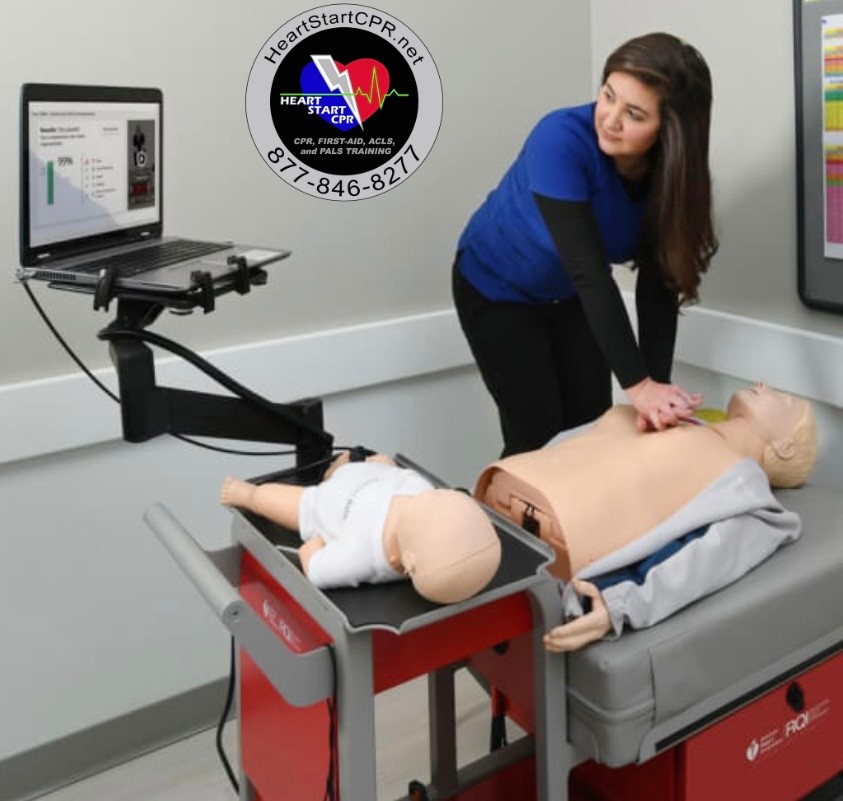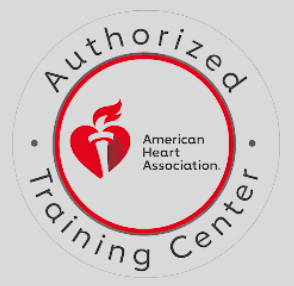BLS Algorithm
The Basic Life Support (BLS) algorithm consists of the steps "Check-Call-Compress-Airway-Breathing" and is used to provide initial emergency care for individuals experiencing cardiac arrest or severe life-threatening conditions:
- Cardiac Arrest
- Drowning
- Choking
- Other life threatening cardiovascular emergencies.
Basic Life Support (BLS) stands as the fundamental cornerstone of emergency medical care, representing the crucial link between a sudden cardiac arrest victim and their chances of survival. In the critical moments before professional medical assistance arrives, the knowledge and swift execution of BLS techniques can make all the difference. This life-saving algorithm comprises a set of easy-to-learn, yet precise, maneuvers designed to sustain vital functions, restore circulation, and maintain oxygenation in individuals experiencing cardiac arrest or life-threatening emergencies.
Algorithms for Basic Life Support
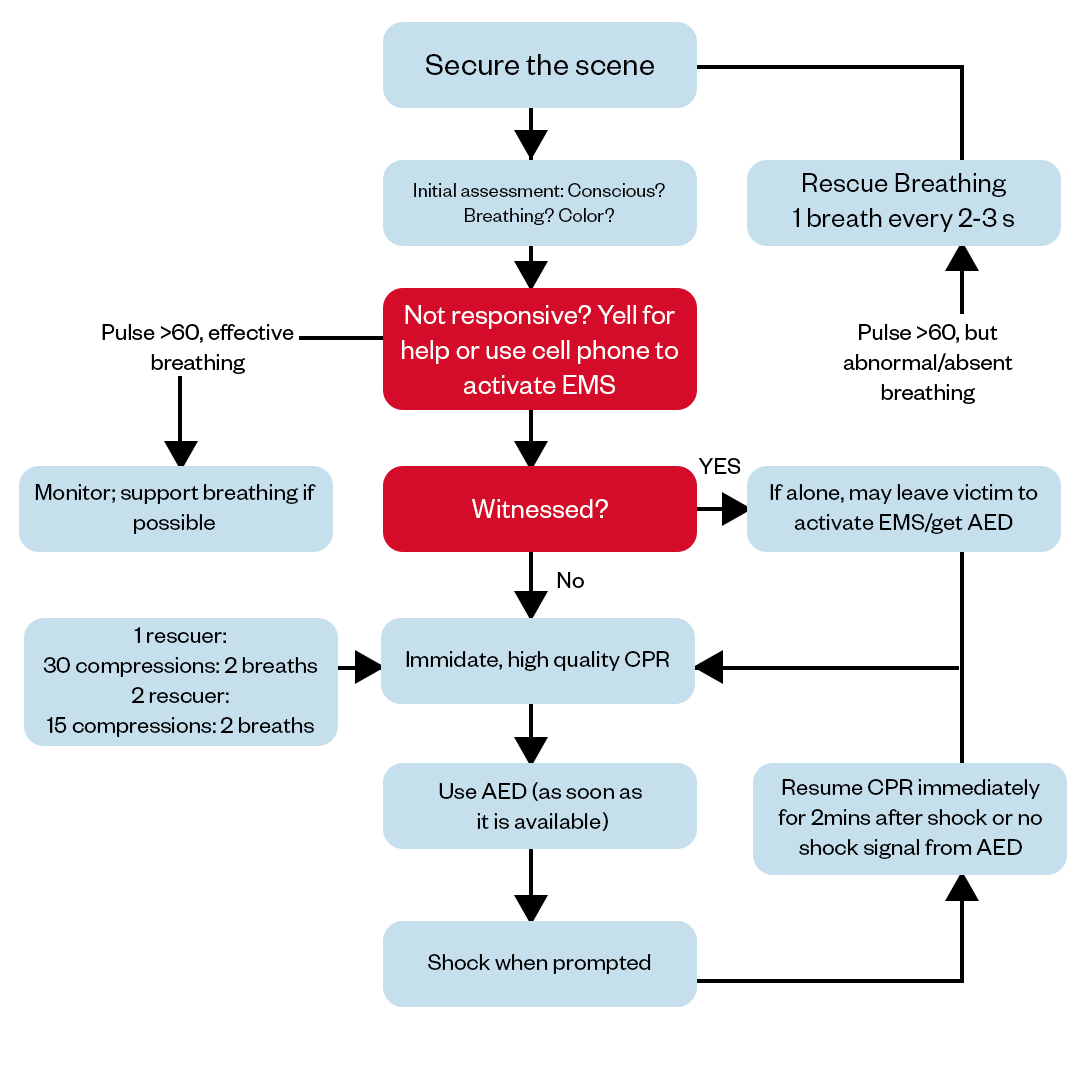
Pediatric BLS Algorithm
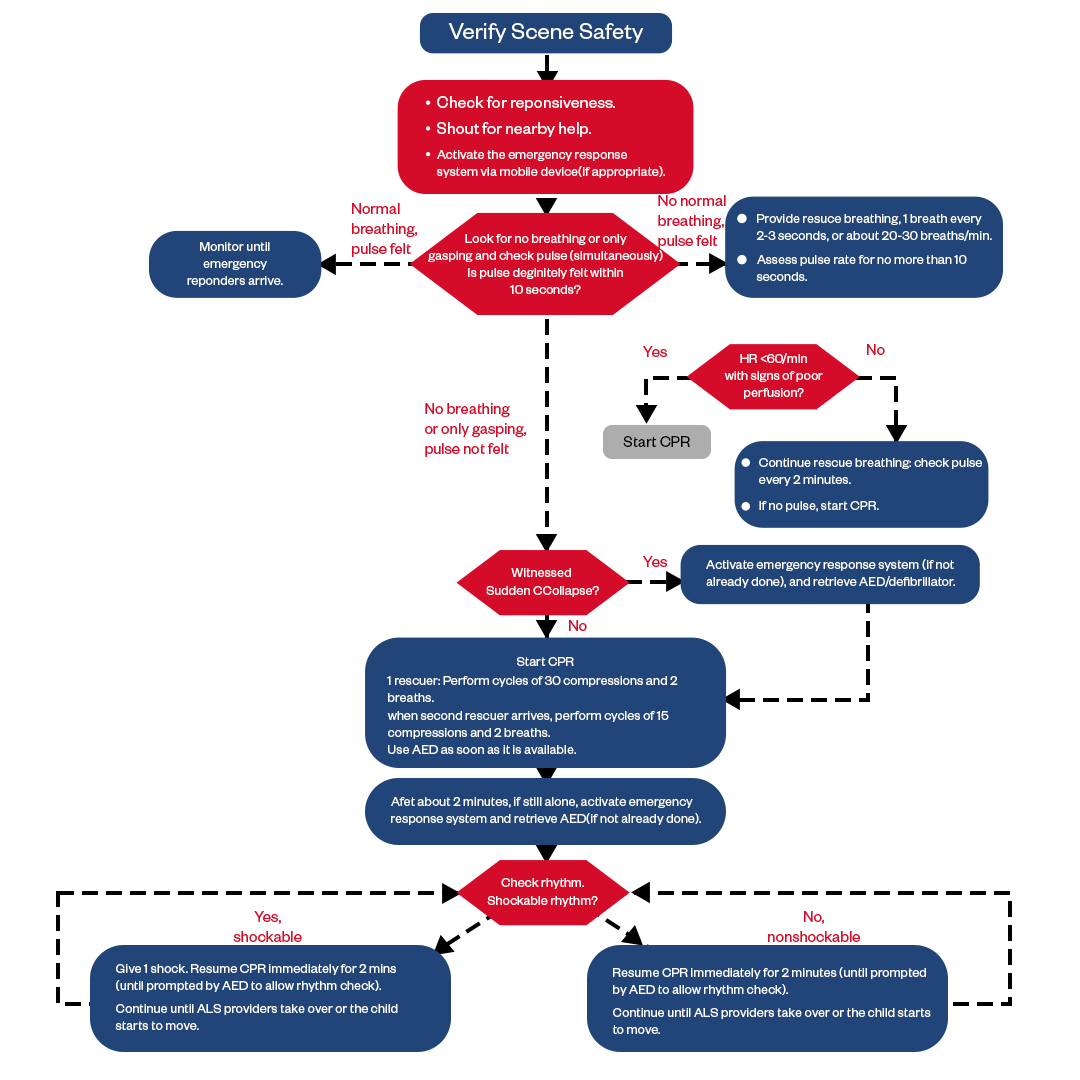
Pediatric BLS Algorithm 1 Rescuer
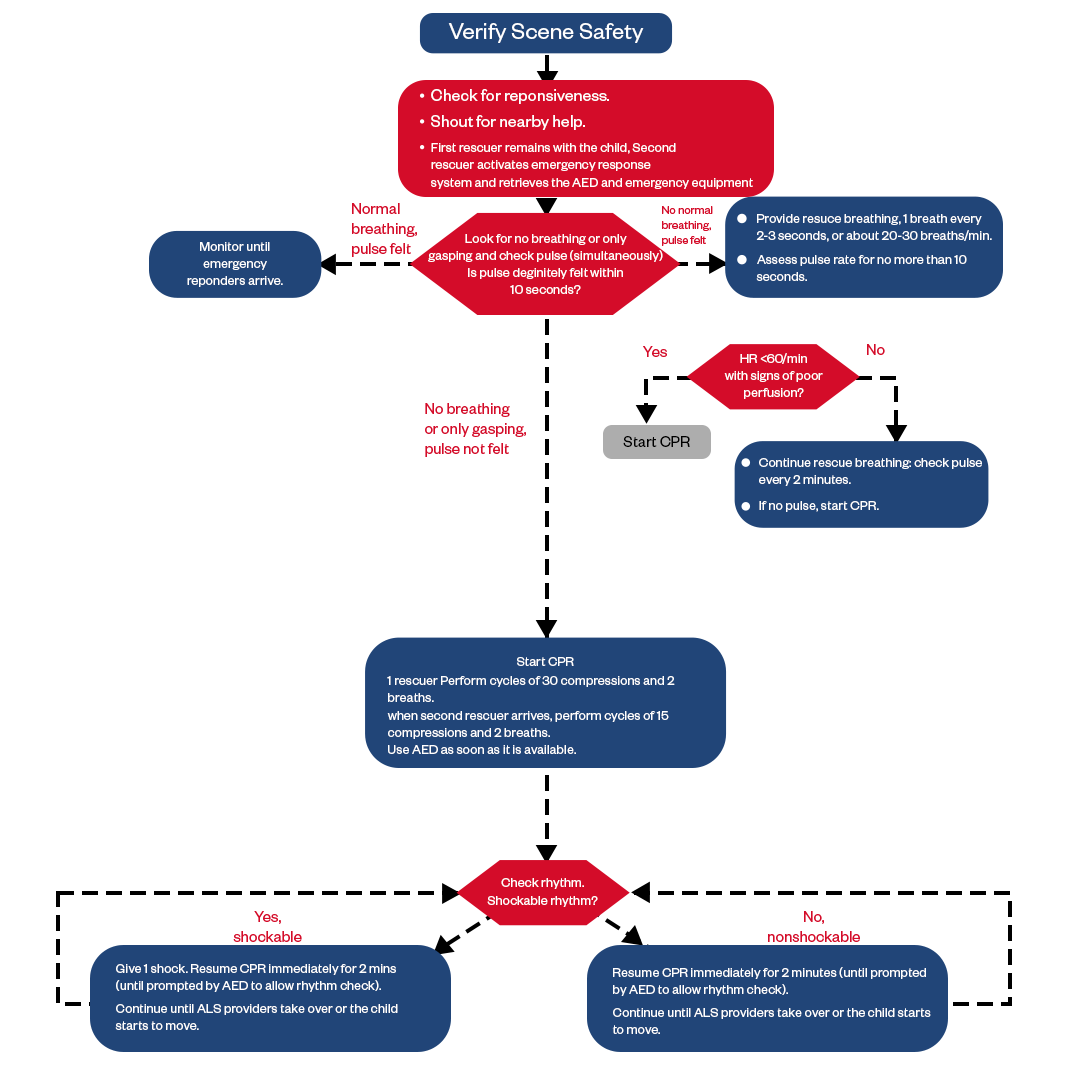
Pediatric BLS Algorithm 2 Rescuer
One Rescuer BLS Algorithm
When it comes to Basic Life Support (BLS), timing and technique are paramount. The One-Rescuer BLS Algorithm represents a vital component of this life-saving protocol. The algorithm addresses situations where a lone rescuer steps forward to administer critical care in those crucial moments of need. The one rescuer BLS algorithm provides a step-by-step understanding and maneuvers required to sustain life during cardiac arrest or other medical emergencies. Whether you find yourself in a healthcare setting or an everyday scenario, mastering the One-Rescuer BLS Algorithm ensures that you possess the skills and confidence to act swiftly and effectively, potentially turning the tide in favor of survival.
One Rescuer BLS Module
- Call 911
- Check responsiveness
- Assess the patient and check pulse
- Check for breathing and clear the airway
- Start chest compressions (30 chest compressions to 2 rescue breaths)
- Provide rescue breaths
- Continue CPR
- Use an AED (if available)
- Continue until professional medical help arrives
Two Rescuer BLS Algorithm
The Two-Rescuer BLS Algorithm represents a synchronized symphony of life-saving expertise. When the urgency of an emergency demands a coordinated effort, this algorithm becomes the backbone of efficient and effective care. The presence of two skilled responders working in harmony can significantly enhance the chances of survival during cardiac arrest or critical medical emergencies.
Two-Rescuer BLS Algorithm highlights the precise techniques and teamwork required to provide optimal care. This protocol trains you and your partner to be well-prepared to deliver synchronized timely interventions that can make a life-or-death difference.
Two Rescuer BLS Module
- Check for responsiveness
- Assess the Patient and Check Pulse
- Check for breathing and clear the airway
- Start chest compressions (30 chest compressions to 2 rescue breaths)
- Provide rescue breaths
- Continue CPR
- Use an AED (if available)
- Continue until professional medical help arrives
One rescuer BLS involves a single responder performing all critical tasks, including chest compressions and ventilations, which can be physically demanding and may lead to fatigue. In contrast, two-rescuer BLS utilizes two responders working in tandem, allowing for more effective chest compressions, consistent ventilation, and better coordination, ultimately improving the quality of care and increasing the chances of survival during cardiac arrest or emergencies.
Special Considerations for Trauma, Pregnant, and Drowning
Pregnant
Modifications in Chest Compressions: When performing chest compressions on a pregnant individual, it's crucial to displace the uterus manually to the left side. This displacement is done to prevent aortocaval compression, where the weight of the uterus can compress the major blood vessels (aorta and vena cava) that run behind it. By moving the uterus to the left, you can improve blood flow and oxygen delivery to the heart and brain. This adaptation is essential to ensure effective chest compressions and avoid compromising both the mother and fetus.
Airway Management: Maintaining a clear and open airway is always a priority in CPR, but pregnant individuals may have unique challenges. Physiological changes during pregnancy, such as an enlarged uterus, can lead to potential airway obstruction. Additionally, there's a risk of regurgitation or aspiration due to pressure on the stomach. Positioning the pregnant individual on their left side is a valuable technique to help prevent these complications. This position can relieve pressure on the diaphragm and stomach, reducing the risk of aspiration.
External Chest Compressions: Due to the increased size of the chest and uterus in pregnant individuals, rescuers may need to exert slightly more force during chest compressions to effectively circulate blood. However, it's essential to maintain the appropriate depth and rate of compressions as recommended in the BLS guidelines. This balance ensures effective resuscitation while minimizing the risk of injury to the mother or fetus.
Trauma
Manual Cervical Spine Stabilization: This is a crucial step when dealing with trauma victims. Trauma to the neck or spine can be life-threatening, and proper immobilization is necessary to prevent additional damage. CPR should be performed with care to avoid unnecessary movement of the cervical spine.
Control of Bleeding: Controlling external bleeding is a top priority in trauma situations. Uncontrolled hemorrhage can lead to rapid deterioration and death. Before initiating CPR, it's important to apply direct pressure to any significant bleeding wounds to stop the bleeding. Hemorrhage control is indeed given precedence.
Airway Management: Maintaining an open and clear airway is essential in any resuscitation effort. However, when dealing with trauma victims, it's crucial to consider potential neck or face injuries. The mention of the "jaw-thrust maneuver without head tilt" is accurate. This technique helps ensure that the airway is kept open without compromising the cervical spine's alignment, as tilting the head can potentially worsen neck injuries.
Avoiding Aggravation of Injuries: This point emphasizes the importance of minimizing further harm when providing CPR to trauma victims. Careful attention should be given to avoid compressions over obvious fractures or areas of injury. This is consistent with the principle of "do no harm."
Drowning
Rapid Assessment: Quickly assessing the patient's responsiveness and breathing status is crucial in drowning cases. If the patient is unresponsive or not breathing normally, CPR for drowning victims should be initiated promptly. Immediate action can be life-saving.
Airway Management: Clearing the airway of any obstructions like water, debris, or vomit is a critical step to ensure effective ventilation. The head-tilt, chin-lift maneuver is a standard technique to open the airway and allow for adequate airflow. Clearing the airway is especially important in drowning cases where airway obstruction is a significant concern.
Early Ventilation: Early rescue breathing is indeed vital in drowning cases. It helps oxygenate the body and improve the chances of a successful outcome. Rescuers should provide proper ventilation with rescue breaths or with an appropriate ventilating device, ensuring an appropriate rate and volume. Effective ventilation is key to reversing hypoxia, which is common in drowning victims.
Hypothermia Management: Drowning victims often experience hypothermia due to prolonged exposure to cold water. Hypothermia can further compromise the body's functions and lead to cardiac arrest. Initiating rewarming measures while providing CPR is essential to prevent further deterioration and optimize the chances of survival. Care should be taken to warm the victim gradually to avoid complications.
Consideration for Aspiration: Drowning victims are at risk of aspirating water into their lungs, which can lead to lung damage and pneumonia. Healthcare providers should closely monitor for signs of respiratory distress or infection and provide appropriate interventions as needed. This may include oxygen therapy, antibiotics, or other treatments to address lung-related complications.
Fast and Convenient
Take BLS Classes
*Nationally Accepted
BLS
CERTIFICATION
AHA BLS course
State-of-the-Art Facilities
Unlimited Exam Retakes
$70
BLS
ONLINE CERTIFICATION
AHA BLS Online Course
100% online training
+Skills Session
$105

